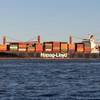Liquefied Petroleum Gas, long a niche product used by the poor to cook and the rich to barbecue, has become a rare bright spot amid a broad commodities rout, riding on the wave of strong economic growth in India and parts of Southeast Asia.
LPG is best known to consumers as propane or butane used in heating appliances and vehicles. But it is also used in the petrochemicals industry and the electricity sector, acting as a replacement for diesel in generators and power stations.
While tumbling prices for oil, gas, coal and industrial metals have seen energy companies and miners slash capital expenditure, investment is flowing into the LPG sector to feed burgeoning demand from the world's poorer nations.
The biggest growth market is India, with its 1.3 billion people and 8 percent economic growth expected this year, where millions of households are switching from kerosene or wood burners to LPG.
"LPG is convenient because it is smoke-free and saves time," said Sunita Nagar, a 45-year-old housewife in the village of Dujana on the outskirts of Delhi, who got her first LPG in July.
Tejveer Singh Nagar, 36, who has a physical disability, has also recently received his first LPG for cooking.
"I'm unmarried. Since I've got LPG I boil milk, and cook myself," he said. "Earlier, I was dependent on my sister-in-law to cook and give me milk."
Indian government data shows that the share of households which have access to LPG has risen from around 50 percent in 2010 to 70 percent this year.
"There is a clear decision to increase LPG penetration as this is a cleaner fuel," said Indrajit Bose, executive director at Indian Oil Corp.
"It cuts pollution and also replaces use of wood as well as animal dung used for cooking in rural India. In the last 5-6 years, the government has been consistently reducing the allocation of subsidized kerosene... Delhi is today kerosene-free."
Shale Revolution
Energy consultancy IHS expects global LPG demand to rise from around 275 million tonnes this year to some 310 million tonnes by 2019, with the biggest growth seen in Asia. That compares with under 250 million tonnes in 2010.
The World Bank says LPG helps reduce poverty, giving millions of households access to cooking heat and electricity for the first time.
"Reduction of extreme poverty is impossible without addressing energy scarcity," said Anita Marangoly George, senior director of Sustainable Development at the World Bank. "We see LPG as crucial in fighting energy poverty."
LPG burns cleaner than wood or kerosene, and although both LPG and kerosene are highly flammable, large conversion programmes such as undertaken in Indonesia show a fall in household accidents following a switch to LPG.
Just as important as the demand growth has been a change in LPG supply.
Previously mostly produced in the Middle East, its rise over the last few years has come as a side-effect of the U.S. shale oil and gas exploration boom, of which LPG is a by-product.
With LPG production from shale soaring since 2006, the United States has this year become the world's biggest exporter.
Its soaring production has also made LPG much cheaper, a key ingredient for its success in developing countries, with U.S. propane prices <PRO-USG> down 70 percent since 2014.
Subsidied Growth
The International Energy Agency (IEA) said this week that investment in the overall oil sector would drop by at least 20 percent this year versus 2014, the biggest fall on record.
While many oil majors like Exxon Mobil or Royal Dutch Shell also trade LPG, it makes up only a small share of their business and they often sell it on to specialized firms who are now taking advantage of cheap LPG to create new markets in developing countries.
"The sea-change of U.S. LPG exports has been fantastic for us," said Theodore Young, chief financial officer of New York-based Dorian LPG, one of the world's biggest shippers of the fuel, which has ordered 19 new vessels to meet demand.
"It's been massive growth of perhaps 4 million tonnes not a decade ago to some 20 million tonnes this year."
LPG is also seeing industrial-scale growth. Malaysia is developing the huge Refinery and Petrochemical Integrated Development (RAPID) project in Johor, close to Singapore's oil hub.
RAPID will have the capacity to store more than 2 million cubic metres of crude oil, refined products, petrochemicals and LPG and plans to start operations in 2019.
One problem the LPG industry could face is a scale-back in subsidies it heavily relies on in many countries.
"A lot of demand for LPG is subsidized," said Walter Hart, Global Lead of Natural Gas Liquids at IHS. "Eventually, the subsidies will be pulled back, and that would result in a lot of subsidized demand growth reduction, for instance in India."
(By Henning Gloystein and Sankalp Phartiyal; Additional reporting by Nidhi Verma and Li Peng Seng; Editing by Alex Richardson)












